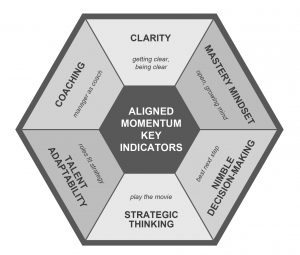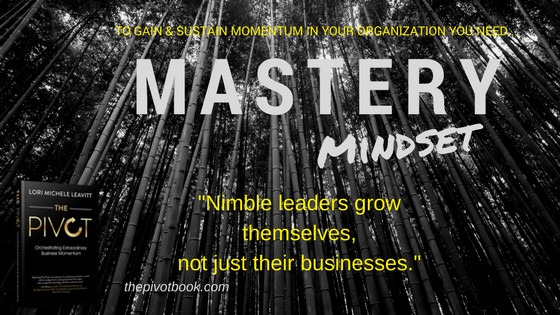Mastery Mindsets are critical to business vibrancy
When I wrote the book The Pivot: Orchestrating Extraordinary Business Momentum, I was somewhat surprised when after boiling down all the possible indicators of what makes a leader successful in leading a vibrant business, and achieving Aligned Momentum, there were just six (listed at the end of this article).
Mastery Mindsets is the second key indicator in the first group of three, which indicate a readiness for brilliant execution of strategy. Your business cannot be vibrant, and you and all those in your organization cannot be nimble, without the openness, curiosity, courage, integrity and grit to continue to grow.
Continued growth is the path of mastery.
You may be wondering how “vibrant business” is defined. I define it as:
A vibrant business commands the highest valuation, stays ahead of the competition, and is a great place to work.
And nimble?
To be nimble, is to be open, aware and purposeful. You rarely get blocked. But if you do get blocked – by something, someone or (even) yourself—you have what it takes to move over, under, through…
If a vibrant business and being nimble is something you want more of – for you, and for all the great people working to achieve the organization’s strategic objectives, there are ways of leading that will help inspire and nurture Mastery Mindsets. Here are 3 ways that even the most conservative, mature company (including its leader) should consider:
- Celebrate curiosity.
- Create a learning culture.
- Invest in innovate thinking and strategic actions.
You will want to model the way so that these 3 ways are simply how everyone behaves and takes action at work.
Celebrate curiosity. The smoothest journey to build Mastery Mindsets involves hiring and promoting only curious people—those who know a lot, but who aren’t know-it-alls. A know-it-all gets easily stuck in how things were done before; it is difficult for them to change. They are not nimble and certainly not wired for mastery. You may be in a situation, though, where you need to do your best to shift fixed mindsets to Mastery and to better support those already wired for mastery.
You can’t change a person but you can change their context at work. You can positively influence the social norms and you can alter the structure, or better yet, put structure more into the hands of the people in your workplace. And you can model the way. You can be more curious.
“I am better off than he is. For he knows nothing and thinks that he knows. I neither know nor think that I know.” ~Socrates
Socrates understood that beginning at a position of intellectual humility was the only method of seeking truth—with no guarantee of finding it. An individual with a Mastery Mindset may be considered an expert, yet he or she is always finding ways to grow even more. Mastery, like success, is a journey.
Create a learning culture. To be nimble and lead a vibrant business, changing for growth—not just revenue and assets but also people and strategic value—requires learning. I remember, when as a manager in a Fortune 100 company, I led a workshop following Peter Senge’s book, The Fifth Discipline: The Art and Practice of a Learning Organization. My peers appreciated it. My boss did not. In fact he was downright hostile throughout my talk and exercise (which was quite fun and got people up and moving around). In hindsight I realize he was a know-it-all (fixed mindset) and likely took any talk of change as blame or attack on his authority. In this organization there was plenty of required training, but there was little learning (feel free to contact me if you are not clear about what I mean by this, and are curious to know). When you consider how to create a learning culture, consider what will nurture Mastery Mindsets.
Invest in innovative thinking and strategic actions. As a leader, you and the leadership team set the strategic direction. And then, if you are a nimble leader, you are communicating that direction and providing support in a variety of ways to enable people closest to the work and the customers, to execute brilliantly. One company often talked about with respect to continuous innovation is Amazon. Andrea Leigh writes that Amazon holds people accountable for innovation. Mike Parsons tells us that by embracing risk and failure, Amazon creates the space for successful innovation. You may not have the risk-tolerance of Amazon CEO, Jeff Bezos, and the many investors, but you can consider how you might create a safer place in which to make mistakes as smart, strategic initiatives are attempted, not all of which will succeed.
And now, those six Aligned Momentum Key Indicators—See the diagram below. You may also download this diagram from the Resources page of thepivotbook.com.


